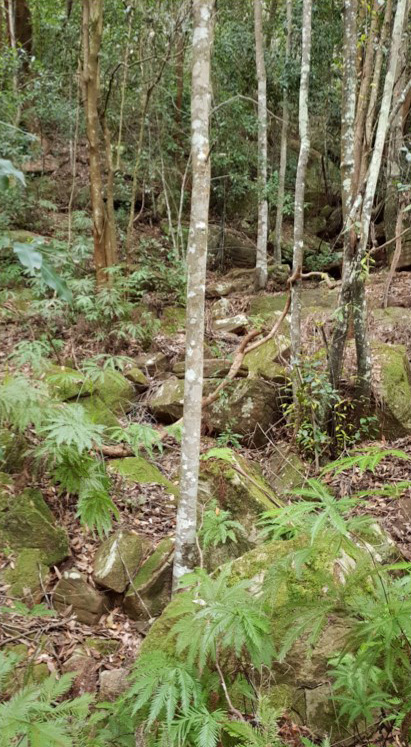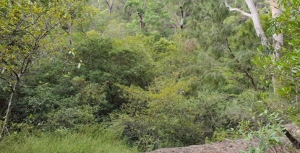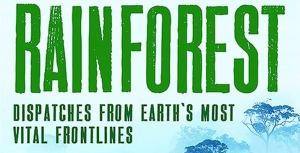Displaying items by tag: rainforest
A Short History of the Coastal Sandstone Gallery Rainforest
The rainforest corridors along the gullies of northern Sydney have been called by many names as ecologists try to describe them and place them into a broader classification system, for example Temperate Rainforest (1), Sandstone Gully Rainforest (2), Coachwood Rainforest (3), Northern Warm Temperate Rainforest (4) and now more recently Coastal Sandstone Gallery Rainforest (5).
While this rainforest forms a highly recognisable ecological community, the history and evolution of the individual plant species are all quite different.
Mosses and liverworts, not the extant species, were the first land plants and appeared around 470 million years ago (Ma) in the Ordovician. It has been speculated that their impact on the earth caused an ice age because of plummeting carbon dioxide (6).
Jumping forward to the mid Devonian (383–393 Ma) and a new group of plants is present, the ferns. Most of the earliest ferns are now extinct and most of our extant ferns date from only the last 70 million years, the late Cretaceous (7). Ferns of the Coastal Sandstone Gallery Rainforest include Common Maidenhair (Adiantum aethiopicum), False Bracken (Calochlaena dubia), Umbrella Fern (Sticherus flabellatus) and tree-ferns (Cyathea species). The origin of the Cyathea tree-ferns goes back to the Jurassic (201–145 Ma) (8) but the diversity in this tree fern family is unlikely to be older than the Palaeocene (younger than 66 million years).
The Umbrella Fern and Coral Fern (Gleichenia species) are considered an ancient fern family and date from at least the early Cretaceous (9) (approx 145 Ma).

Ancestry from millions of years ago: mosses from 470 Ma, Umbrella Fern from approx 145 Ma and Coachwoods from approx 34–28 Ma (photo Robin Buchanan)
The trees that dominate the Coastal Sandstone Gallery Rainforest are all flowering plants. The earliest fossil records of a flowering plant date from early Jurassic (10), more than 174 Ma but the diversification and dominance of flowering plants occurred from the Cretaceous (145–66 Ma) to more recent times (11). The main tree families of the rainforest include Myrtaceae, Cunoniaceae and Pittosporaceae.
Myrtaceae is an enormous family that has 1646 species in Australia and 3000 in the world (12). It is also very diverse with dry fruited plants typical of dry sclerophyll, such as Eucalyptus, and fleshy fruited plants typical of rainforests. It is primarily a southern hemisphere family with considerable northern extension. Crown Myrtaceae seem to date from only 95–84 Ma (13) (mid to upper Cretaceous). Species common in the Gallery Rainforest include Narrow-leaf Myrtle Austromyrtus tenuifolia, Grey Myrtle Backhousia myrtifolia, Water Gum Tristaniopsis laurina and Lilly Pilly Acmena smithii.
The Cunoniaceae is a small family with a Gondwanan origin and seems to date back to late Cretaceous. This family includes the trees Coachwood Ceratopetalum apetalum and Black Wattle Callicoma serratifolia. Ceratopetalum and Callicoma had evolved by the early Oligocene (34–28 Ma) or earlier (14).
Pittopsporaceae, containing Mock Orange Pittosporum undulatum, seems to have originated in Australasia in the early Cretaceous (approx 117 Ma) (15).
Australia’s rainforests are a mere remnant of their former glory in the early Miocene (c23–16 Ma) when they were wide spread. By the late Miocene (10.5–5 Ma) the drying out of Australia had resulted in forests and woodlands across Australia and the remnants of the rainforests were confined to the wetter coastal areas of Australia (16).
In the northern suburbs there are also smaller stands of Coastal Warm Temperate Rainforest, Coastal Escarpment Littoral Rainforest and Coastal Headland Littoral Rainforest (5) but the Coastal Sandstone Gallery Rainforest is far the most common.
References
- Robinson, L (1991) Field Guide to the Native Plants of Sydney, Kangaroo Press
- Martyn, J (2010) Field Guide to the Bushland of the Lane Cove Valley, STEP
- Smith Ecological Consultants (2008) Native Vegetation Communities of Hornsby Shire
- Keith, D (2004) Ocean Shores to Desert Dunes, NSW NPWS
- Office of Environment and Heritage (2016) The Native Vegetation of the Sydney Metropolitan Area. Vol 2: Vegetation Community Profiles, ver 3
- Marshall, M (2012) First plants plunge earth into ice age New Scientist
- Pinson, J About Ferns American Fern Society
- Bystriakova, N et al (2011) Evolution of the climatic niche in scaly tree ferns (Cyatheaceae, Polypodiopsida) Botanical Journal of the Linnean Society 165(1), 1–19
- Gonzales, J and Kessler, M (2011) A synopsis of the Neoptropical species of Sticherus (Gleicheniaceae), with descriptions of nine new species Phytotaxa 31, 1–54
- eLife (2018) Fossils suggest flowers originated 50 million years earlier than thought ScienceDaily
- Foster, C (2016) The evolutionary history of flowering plants Journal and Proceedings of the Royal Society of New South Wales 149(1&2) 65–82
- Centre for Biodiversity Research (2002) Australian Flora and Vegetation Statistics
- Stevens, PF (2001 onwards) Angiosperm Phylogeny Website, ver 14, July 2017 (and more or less continuously updated since)
- Barnes, R (1999) Palaeobiogeography, extinctions and evolutionary trends in the Cunoniaceae: A synthesis of the fossil record PhD thesis, University of Tasmania
- Nicolas, N and Plunkett, G (2014) Diversification times and biogeographic patterns in Apiales Botanical Review 80(1) 30–58
- Australian Museum (2018) Evolving Landscapes
Photo at the top of the page: dense foliage of Coachwoods and Black Wattle in the rainforest lining the creek between eucalyptus dominated slopes (photo Robin Buchanan)
Robin Buchanan
Book Review – Rainforest: Dispatches from Earth's most Vital Frontlines
There are many books on the environment, as you will see if you scan the shelves of bookshops like Kinokuniya, Abbeys or the Botanic Gardens. Many are well written too, vividly conveying an author's enthusiasm and love of nature though usually with guarded warnings about the future. But I stumbled on one recently that's exceptional. Written by Tony Juniper, long time campaign head and rainforest guru for Friends of the Earth and currently of WWF, it covers a vast spread of information on this precious global asset.
Juniper describes and highlights the enormous diversity of flora and fauna in rainforests both tropical and temperate, of which many people are already aware of course, but what I found compelling were the insights into the negative effects of clearing of rainforest on the mistaken philosophy that rainforest stands in the way of progress. This has effects not only on diversity but also on climate. He highlights research on the cyclical relationship of transpiration and rainfall, pointing to the enormous surface area of foliage available for evaporation – far more than if the same area were covered by water. He also, alarmingly, points to increasing drought in cleared land, and in agricultural land, savanna, and semi desert up to thousands of kilometres from retreating forests. (And yet we still allow tree clearing in this drought-ridden country?)
The diversity of course includes the traditional inhabitants, dismissed as of little consequence or an obstacle by European settlers and governments, from Theodore Roosevelt's ‘tenantless wilderness’ to our very own terra nullius. The chapter on the Amazon Basin is particularly illuminating because it highlights how the original people farmed the fertile flood plains, not by wholesale clearing but by retaining the canopy trees because they protect and enhance the soil and its moisture and fertility. Rainforest crops like cocoa and coffee grow best in protected settings. Wholesale clearing to plant oil palms and soya beans however is already having alarming consequences. (I rummaged through the pantry and fridge to see if we had anything containing palm oil to chuck; and then what about soya products?)
Tony Juniper is a veteran and very effective environmental campaigner and appears to have sufficient people skills to get opposing factions onside, despite being arrested and marched off at gunpoint in Davos. This includes both big business, politicians and land managers, including indigenous ones, and there is hope for the future beginning to dawn, but a lot more progress needs to be made, and soon!
This book is a must-read for politicians and land managers, especially many of the former! Oh, and Prince Charles gets a guernsey for his forest support – a good choice for future king I think!
Rainforest: Dispatches from Earth's most Vital Frontlines by Tony Juniper, Profile Books, London, 2018, 448 pp
John Martyn reckons this is the best environmental book he has ever read!


